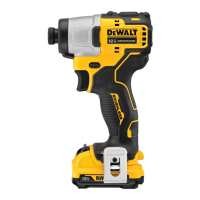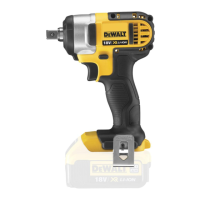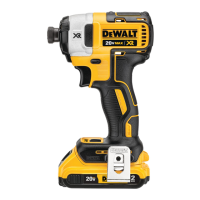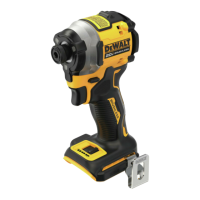11
ENGLISH
Anvil With Hog Ring (Fig.G)
DCF902
WARNING: Use only impact accessories. Non-impact
accessories may break and cause a hazardous condition.
Inspect accessory prior to use to ensure that it contains
nocracks.
CAUTION: Inspect anvils, detent pins, and hog rings prior
to use. Missing or damaged items should be replaced
beforeuse.
Place the forward/reverse button
4
in the locked off (centre)
position or remove battery pack before changingaccessories.
To install an accessory on the hog ring anvil, firmly push
accessory onto the anvil
10
. The hog ring
11
compresses to
allow the accessory to slide on. After accessory is installed, the
hog ring applies pressure to help provide accessoryretention.
To remove an accessory, grasp the accessory and firmly pull
itoff.
Usage
Your impact tool generates the following maximum torque:
Cat # Nm Ft.-Lbs. In.-Lbs
DCF801 160 118.5 1422
DCF902 163 120.7 1448
CAUTION: Ensure fastener and/or system will withstand
the level of torque generated by the tool. Excessive torque
may cause breakage and possible personalinjury.
1. Place the accessory on the fastener head. Keep the tool
pointed straight at thefastener.
2. Press switch to start operation. Release the switch to stop
operation. Always check torque with a torque wrench, as
the fastening torque is affected by many factors including
the following:
- Voltage: Low voltage, due to a nearly discharged
battery, will reduce fasteningtorque.
- Accessory size: Failure to use the correct accessory size
will cause a reduction in fasteningtorque.
- Bolt Size: Larger bolt diameters generally require
higher fastening torque. Fastening torque will also vary
according to length, grade, and torquecoefficient.
- Bolt: Ensure that all threads are free of rust and other
debris to allow proper fasteningtorque.
- Material: The type of material and surface finish of the
material will affect fasteningtorque.
- Fastening Time: Longer fasten ing time results in
increased fastening torque. Using a longer fastening
time than recom mended could cause the fasteners to
be overstressed, stripped ordamaged.
MAINTENANCE
Your DeWALT power tool has been designed to operate
over a long period of time with a minimum of maintenance.
Continuous satisfactory operation depends upon proper tool
care and regularcleaning.
WARNING: To reduce the risk of serious personal
injury, turn tool off and disconnect battery pack
before making any adjustments or removing/
installing attachments or accessories. An accidental
start-up can causeinjury.
The charger and battery pack are notserviceable.
Lubrication
Your power tool requires no additionallubrication.
Cleaning
WARNING: Blow dirt and dust out of the main housing
with dry air as often as dirt is seen collecting in and around
the air vents. Wear approved eye protection and approved
dust mask when performing thisprocedure.
WARNING: Never use solvents or other harsh chemicals
for cleaning the non-metallic parts of the tool. These
chemicals may weaken the materials used in these parts.
Use a cloth dampened only with water and mild soap.
Never let any liquid get inside the tool; never immerse any
part of the tool into aliquid.
Optional Accessories
WARNING: Since accessories, other than those offered
by DeWALT, have not been tested with this product, use
of such accessories with this tool could be hazardous.
To reduce the risk of injury, only
DeWALT recommended
accessories should be used with thisproduct.
Consult your dealer for further information on the
appropriateaccessories.
Protecting the Environment
Separate collection. Products and batteries marked
with this symbol must not be disposed of with normal
householdwaste.
Products and batteries contain materials that can
be recovered or recycled reducing the demand for raw
materials. Please recycle electrical products and batteries
according to local provisions. Further information is available at
www.2helpU.com.
Rechargeable Battery Pack
This long life battery pack must be recharged when it fails
to produce sufficient power on jobs which were easily done
before. At the end of its technical life, discard it with due care for
our environment:
• Run the battery pack down completely, then remove it from
thetool.
• Li-Ion cells are recyclable. Take them to your dealer or a
local recycling station. The collected battery packs will be
recycled or disposed ofproperly.

